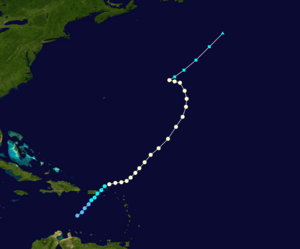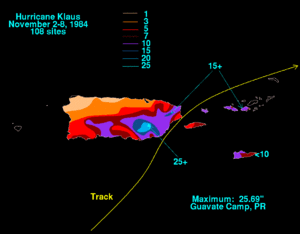Hurricane Klaus (1984) facts for kids
| Category 1 hurricane (SSHWS/NWS) | |

Hurricane Klaus at peak intensity northeast of the Leeward Islands on November 9
|
|
| Formed | November 5, 1984 |
|---|---|
| Dissipated | November 16, 1984 |
| (Extratropical after November 13, 1984) | |
| Highest winds | 1-minute sustained: 90 mph (150 km/h) |
| Lowest pressure | 971 mbar (hPa); 28.67 inHg |
| Fatalities | 2 direct |
| Damage | $152 million (1984 USD) |
| Areas affected | Puerto Rico, Leeward Islands |
| Part of the 1984 Atlantic hurricane season | |
Hurricane Klaus was a powerful storm that formed in the Atlantic Ocean in November 1984. It was part of the 1984 Atlantic hurricane season. Klaus moved towards the Leeward Islands from an unusual direction – the west! This surprised many people.
The storm started as a low-pressure area on November 5. It then moved northeast. Klaus made landfall on the eastern part of Puerto Rico. After that, it passed north of the Leeward Islands. This caused strong winds and rough seas.
Klaus became a hurricane and reached its strongest winds of 90 mph (145 km/h). It later weakened over cooler waters by November 13. The hurricane brought a lot of rain to Puerto Rico. This caused some minor flooding and light damage. Klaus also caused a lot of damage to boats and ships in the Leeward Islands. At least three ships were wrecked. The Virgin Islands also had significant damage.
Contents
How Hurricane Klaus Formed and Moved
Hurricane Klaus began as a large area of low pressure. This happened in the southeastern Caribbean Sea on November 1. It slowly moved west and became more organized. By November 4, the system stopped near Curaçao. Then it turned and started moving northeast.
On November 5, this system officially became Tropical Depression Fifteen. At first, it was weak with winds of only 20 mph (32 km/h). But it kept getting stronger as it moved northeast. On November 6, a special aircraft called a Reconnaissance Aircraft confirmed the storm. It was located between Puerto Rico and the Netherlands Antilles. Later that day, it became Tropical Storm Klaus, just south of Puerto Rico.
Klaus's Path and Strength
Tropical Storm Klaus continued moving northeast. It made landfall on eastern Puerto Rico early on November 7. The storm then passed just north of the Lesser Antilles. This was unusual because it was the first time a tropical storm affected these islands from the west.
The conditions were good for the storm to grow stronger. Klaus became a hurricane early on November 8. It then sped up towards the northeast. The hurricane reached its strongest point with winds of 90 mph (145 km/h) late on November 8. It stayed this strong for about 30 hours.
Later, Klaus started to weaken a little. It interacted with another weather system, which made it turn west on November 11. But then, another weather system called a trough made it turn back to the northeast. On November 12, colder air and water caused Klaus to weaken. It changed into a subtropical storm. It moved faster to the northeast and became an extratropical storm on November 13. This was about 440 miles (700 km) south-southeast of Cape Race, Newfoundland. Six hours later, another weather system absorbed it.
Getting Ready for the Storm
Soon after Klaus formed, warnings were sent out. These were called gale warnings. They were for places like Puerto Rico, the Virgin Islands, the Netherlands Antilles (part of the Leeward Islands), Saint Kitts and Nevis, and Anguilla.
Because Klaus was the first tropical storm to hit the Leeward Islands from the west, many people were not ready. They did not expect strong winds and rough seas coming from that direction.
How Hurricane Klaus Affected People and Places
As Tropical Storm Klaus moved past Puerto Rico, it brought a lot of rain. The most rain, about 25.69 inches (653 mm), fell in Guavate Camp. Much of southern Puerto Rico received over 7 inches (178 mm) of rain. Vieques got about 7 inches, and Culebra had over 10 inches. This heavy rain caused freshwater flooding.
The strongest winds of the storm stayed offshore. Wind gusts reached 37 mph (60 km/h) at Roosevelt Roads Naval Station. The winds and rain caused some trees and power lines to fall. However, the damage was not very bad. Klaus hit Puerto Rico on election day, which caused small delays in voting.
Impact on the Virgin Islands and Leeward Islands
Saint John in the United States Virgin Islands received over 15 inches (380 mm) of rain from Tropical Storm Klaus. Both Saint Thomas and Saint Croix got around 10 inches (250 mm). The British Virgin Islands had less than 10 inches of rain.
Tropical Storm Klaus caused serious flooding and a lot of damage in the U.S. Virgin Islands. Strong winds from the southwest caused gale-force winds and rough seas. This led to a lot of damage for boats and ships in the area. In Anguilla, three ships were wrecked.
About 1 mile (1.6 km) off Saint Martin, rough seas wrecked a cruise ship. All 60 passengers and 23 crew members swam safely to shore. One person had to go to the hospital. The rough seas also damaged local coral reefs.
On the island of Dominica, 10,000 people were affected. The storm caused $2 million (1984 USD) in damage there. Sadly, two people died. In Antigua, strong waves caused severe beach erosion. This put a highway behind an eroded beach in danger. Beach erosion was also reported in nearby Barbuda.
The British Virgin Islands had moderate damage, totaling $152 million (1984 USD). Saint Kitts and Nevis also saw a lot of damage along their western coast. The worst impact was the destruction of the Sandy Point town port in Saint Kitts.
What Happened After the Storm
In Anguilla, nine ships, including the three that were wrecked by the hurricane, were later sunk on purpose in 1990. This was done to create an artificial reef for marine life.
About a month after the storm, President Ronald Reagan declared the U.S. Virgin Islands a major disaster area. This meant that federal money could be used to help with recovery. The Federal Emergency Management Agency (FEMA) gave about $2,128 (1984 USD) to each person affected. This was the smallest amount of aid given for a declared disaster in the Virgin Islands.
Because the damage from Hurricane Klaus in 1984 was not extremely severe, its name was not removed from the list of hurricane names that year. However, the name Klaus was later retired after Hurricane Klaus in 1990. That storm, surprisingly, caused less damage. The name Klaus was replaced by Kyle in 1996.



